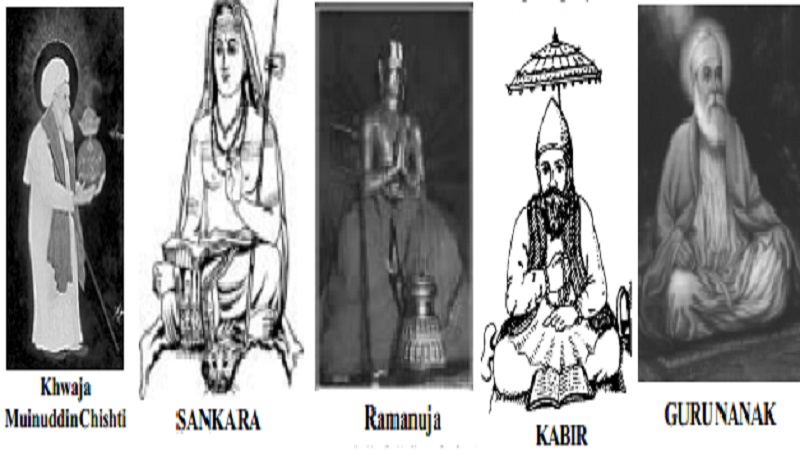Chapter: 11th 12th std standard History autobiography life Higher secondary school College Notes
Bhakti Movement - Ramananda, Kabir, Guru Nanak, Chaitanya, Gnanadeva, Namadeva, Ekanatha

Bhakti Movement
In the ninth century Sankara started a Hindu revivalist movement giving a new orientation to Hinduism. He was born in Kaladi in Kerala. His doctrine of Advaita or Monism was too abstract to appeal to the common man.
Moreover, there was a reaction against the Advaita concept of Nirgunabrahman (God without attributes) with the emergence of the idea of Sagunabrahman (God with attributes).In the twelfth century, Ramanuja, who was born at Sriperumbudur near modern Chennai, preached Visishtadvaita.
According to him God is Sagunabrahman. The creative process and all the objects in creation are real but not illusory as was held by Sankaracharya. Therefore, God, soul, matter are real. But God is inner substance and the rest are his attributes. He also advocated prabattimarga or path of self-surrender to God. He invited the downtrodden to Vaishnavism.
In the thirteenth century, Madhava from Kannada region propagated Dvaita or dualism of Jivatma and Paramatma.
In the fourteenth and fifteenth centuries, Ramananda, Kabir and Nanak remained great apostles of the Bhakti cult. They drew inspiration from old masters but showed a new path. They helped the common people to shed age-old superstitions and attain salvation through Bhakti or pure devotion. Unlike the early reformers, they were not linked with any particular religious creed and did not believe in rituals and ceremonies. They condemned polytheism and believed in one god. They also denounced all forms of idolatry. They strongly believed in Bhakti as the only means of salvation. They also emphasised the fundamental unity of all religions.
Ramananda
Ramananda was born at Allahabad. He was originally a follower of Ramanuja. Later he founded his own sect and preached his principles in Hindi at Banaras and Agra. He was a worshipper of Rama. He was the first to employ the vernacular medium to propagate his ideas. Simplification of worship and emancipation of people from the traditional caste rules were his two important contributions to the Bhakti movement. He opposed the caste system and chose his disciples from all sections of society disregarding caste. His disciples were: a) Kabir, a Muslim weaver b) Raidasa, a cobbler c) Sena, a barber d) Sadhana, a butcher e) Dhanna, a Jat farmer f) Naraharai, a goldsmith and g) Pipa, a Rajput prince.
Kabir
Among the disciples of Ramananda the most famous was Kabir. He was born near Banaras to a brahmin widow. But he was brought up by a Muslim couple who were weavers by profession.
He possessed an inquiring mind and while in Benares learnt much about Hinduism. He became familiar with Islamic teachings also and Ramananda initiated him into the higher knowledge of Hindu and Muslim religious and philosophical ideas. Kabir's object was to reconcile Hindus and Muslims and establish harmony between the two sects. He denounced idolatry and rituals and laid great emphasis on the equality of man before God. He emphasised the essential oneness of all religions by describing Hindus and Muslims 'as pots of the same clay'. To him Rama and Allah, temple and mosque were the same. He regarded devotion to god as an effective means of salvation and urged that to achieve this one must have a pure heart, free from cruelty, dishonesty, hypocrisy and insincerity. He is regarded as the greatest of the mystic saints and his followers are called Kabirpanthis.
Guru Nanak
Another well-known saint-preacher of the medieval period was Guru Nanak, founder of the Sikh religion and a disciple of Kabir. He was born in Talwandi near Lahore. He denounced caste distinctions and rituals like bathing in holy rivers. His conception of religion was highly practical and sternly ethical. He exhorted people to give up selfish- ness, falsehood and hypocrisy and to lead a life of truth, honesty and kindness. 'Abide pure amidst the impurities of the world' was one of his famous sayings. His life was dedicated to establishing harmony between Hindus and Muslims. His followers were known as Sikhs.
Chaitanya was another well-known saint and reformer of Bengal who popularised the Krishna cult. He renounced the world, became an ascetic and wandered all over the country preaching his ideas. He proclaimed the universal brotherhood of man and con-demned all distinction based on religion and caste. He emphasised love and peace and showed great sympathy to the sufferings of other people, especially that of the poor and the weak. He believed that through love and devotion, song and dance, a devotee can feel the presence of God. He accepted disciples from all classes and castes and his teachings are widely followed in Bengal even today.
Gnanadeva was the founder of the Bhakti Movement in Maharashtra in the thirteenth century. It was called Maharashtra dharma. He wrote a commentary of Bhagavat Gita called Gnaneswari. Namadeva preached the gospel of love. He opposed idol worship and priestly domination. He also opposed the caste system. In the sixteenth century, Ekanatha opposed caste distinctions and sympathetic towards the lower castes. He composed many lyrics and his bhajans and kirtans were famous. Another Bhakti saint of Maharashtra was Tukaram, a contemporary of Sivaji. He was responsible for creating a background for Maratha nationalism. He opposed all social distinctions.
Related Topics